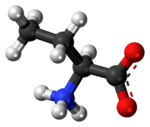alpha-Aminobutyric acid
α-Aminobutyric acid (AABA), also known as homoalanine in biochemistry, is a non-proteinogenic alpha amino acid with chemical formula C4H9NO2. The straight two carbon side chain is one carbon longer than alanine, hence the prefix homo-.
 | |
 | |
| Names | |
|---|---|
| IUPAC name
2-Aminobutanoic acid | |
| Other names
2-Aminobutyric acid; α-Aminobutanoic acid; Ethylglycine; Homoalanine | |
| Identifiers | |
3D model (JSmol) |
|
| ChEBI | |
| ChEMBL | |
| ChemSpider | |
| ECHA InfoCard | 100.018.742 |
PubChem CID |
|
| UNII | |
CompTox Dashboard (EPA) |
|
| |
| |
| Properties | |
| C4H9NO2 | |
| Molar mass | 103.12 g/mol |
| Acidity (pKa) | 2.55 (carboxyl), 9.60 (amino)[1] |
| -62.1·10−6 cm3/mol | |
Except where otherwise noted, data are given for materials in their standard state (at 25 °C [77 °F], 100 kPa). | |
| Infobox references | |
Homoalanine is biosynthesised by transaminating oxobutyrate, a metabolite in isoleucine biosynthesis. It is used by nonribosomal peptide synthases. One example of a nonribosomal peptide containing homoalanine is ophthalmic acid, which was first isolated from calf lens.
α-Aminobutyric acid is one of the three isomers of aminobutyric acid. The two other are the neurotransmitter γ-Aminobutyric acid (GABA) and β-Aminobutyric acid (BABA) which is known for inducing plant disease resistance.
References
- Dawson, R.M.C., et al., Data for Biochemical Research, Oxford, Clarendon Press, 1959.
This article is issued from Wikipedia. The text is licensed under Creative Commons - Attribution - Sharealike. Additional terms may apply for the media files.